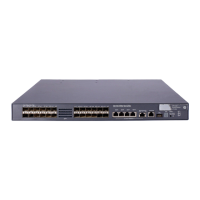189
To do... Use the command... Remarks
2. Create a class and enter class
view
traffic classifier tcl-name [ operator
and ]
3. Specify a foreign CVLAN as a
match criterion
if-match customer-vlan-id vlan-id
4. Specify a local SVLAN as a match
criterion
if-match service-vlan-id vlan-id
5. Return to system view
quit
Required.
Repeat these steps to
create one class for each
local SVLAN and foreign
CVLAN pair.
6. Create a traffic behavior and enter
traffic behavior view
traffic behavior behavior-name
7. Configure a CVLAN marking
action to replace the foreign
CVLAN ID with a local CVLAN ID
remark customer-vlan-id vlan-id
8. Return to system view
quit
Required.
Repeat these steps to
configure one CVLAN
marking action for each
local SVLAN and foreign
CVLAN pair.
9. Create a QoS policy and enter
QoS policy view
qos policy policy-name Required.
10. Associate the class with the
behavior
classifier tcl-name behavior behavior-
name
Required.
Repeat this step to create
other class-behavior
associations.
Configuring a downlink policy for the customer-side port
The downlink policy on the customer-side port replaces local SVLAN and CVLAN pairs with foreign
SVLAN and CVLAN pairs.
To configure a downlink policy for the customer-side port:
To do... Use the command... Remarks
1. Enter system view
system-view —
2. Create a class and enter class
view
traffic classifier tcl-name [ operator
and ]
3. Specify a local CVLAN as a match
criterion
if-match customer-vlan-id vlan-id
4. Specify a local SVLAN as a match
criterion
if-match service-vlan-id vlan-id
5. Return to system view
quit
Required.
Repeat these steps to
create one class for each
local CVLAN and SVLAN
pair.
6. Create a traffic behavior and enter
traffic behavior view
traffic behavior behavior-name
7. Configure a CVLAN marking
action to replace the local CVLAN
ID with a foreign CVLAN ID
remark customer-vlan-id vlan-id
8. Configure an SVLAN marking
action to replace the local SVLAN
ID with a foreign SVLAN ID
remark service-vlan-id vlan-id
9. Return to system view
quit
Required.
Repeat these steps to
create one VLAN marking
behavior for each local
CVLAN and SVLAN pair.

